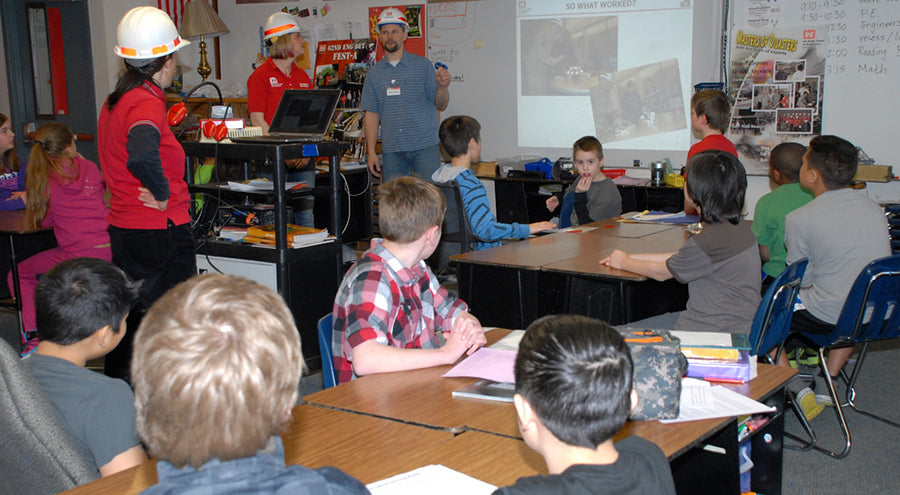This week, I read a fascinating article on the NSTA Blog about how some schools are shaking up their science fair programs. Many schools are aiming to incorporate interdisciplinary approaches to learning in order to improve creativity and involvement with both the community and their own projects (parents, it’s your kid’s time to learn!). The ideas I read about in the article (which I will discuss later, don’t worry) led to me learning about a newer movement in education that I had never heard about: STEM to STEAM. Behind this movement is the argument that the addition of an “A” for “Arts” to the STEM formula will help increase student creativity and engagement.
So, for this week’s blog, I want to discuss this possibly shifting educational paradigm, STEM in general, and science fairs.
According to the Encyclopedia Britannica, the term STEM, which, for those who don’t know by now, stands for “Science, Technology, Engineering, and Mathematics,” was officially adopted in the United States by the U.S. National Science Foundation (NSF) in 2001. This was done because several comparative reports showed the U.S. losing ground in performance to other developed nations in the fields of mathematics and science, and we reasonably began to worry about having a national workforce that was noncompetitive and under-prepared for the increasingly tech-driven economy of the future.
That means that my schooling experience throughout my life completely encompassed the implementation STEM curriculums in U.S. schools from its start up until just a few years ago. Now that I am done with school in my life, I work as a writer with a bachelor’s degree in the field. Whatever encouragement my schooling gave me to pursue STEM did not inspire me to take up a future in a STEM field. That isn’t to say I don’t find science or math interesting (I mean, I work at a science company!). However, I always just coasted by in those classes, performing well but not having interest in taking higher level classes when the opportunity presented itself to me. I always desired a strong layman’s understanding of science, but not an in-depth knowledge of the hard-math that goes into it. My real interests lied in my reading, writing, and music classes.
Because of my experience described above, reading that there is a movement to incorporate the arts and turn STEM into STEAM really piqued my interest. Would including art into my science education have put me on a different path in life? I can’t know for sure, and I’m happy where I’m at now, but I wonder whether pushes for STEAM curricula in the U.S. will lead to a future where my kids and grandkids are busily working at ensuring this country stays on top of the worlds of tech and science.
Proponents of STEAM over STEM argue that STEM, while vitally important, still segments off technical and complex subjects into dry lessons that don’t cultivate the creativity or innovation that one learns from studying art and design principles. There is even some research that connects the arts to the sciences. According to a 2013 study out of Michigan State University, when looking at a sample of graduates from 1990 to 1995, they found “those who own businesses or patents received up to eight times more exposure to the arts as children than the general public.” Particularly, they found that “93 percent of the STEM graduates reported musical training at some point in their lives, as compared to only 34 percent of average adults,” and that they also reported “higher-than-average involvement in the visual arts, acting, dance and creative writing.” They concluded that these findings make sense considering that artistic skills like “analogies, playing, intuition and imagination” lead to original and inventive thinking.
This blog post on Education Week discusses the debate between STEM and STEAM well. They describe that proponents of STEM over STEAM argue that STEM lessons naturally incorporate art via design, communication, and the social contexts of the problems their classes look into, and they worry that any focus on art will undermine STEM’s goal of producing more science-minded students and workers. STEAM advocates, however, think that art serves multiple purposes in STEM education. They argue that art brings more students towards science and math by attracting the artsier students to the field – it is, in a sense, used to recruit creative types into the field. Perhaps I myself would have fallen into this category. They also argue that art encourages questioning and curiosity rather than making students view the act of questioning as an admission of ignorance.
As the debate continues, however, STEAM advocates are charging forward trying to define what a STEAM approach to learning looks like. The website EducationCloset has some fairly in-depth writing on the subject. When answering the question “Who Are the STEAM Teachers?” they give a simple response: everyone. In an ideal STEAM learning environment, teachers coordinate with each other, teaching their students individual concepts separately so that, when appropriate, a STEAM lesson can be taught that gets students to apply their previous lessons and learn them more deeply. In their article “What is STEAM?," they lay out certain things schools must consider when applying STEAM: collaboration across teachers, a flexible schedule, professional training in STEAM (either through school programs like this one at Concordia University or through certification programs), and the alignment of the standards they use to assess their students in various disciplines. Ultimately, these advocates want to change the approach to education in America and provide its students with a propensity for asking deep question and collaborating to find answers to real-life questions.
Now that you have a basic understanding of STEAM, its time for me to return to science fairs and science projects, as they are some of the first to show off the results of a STEAM approach to science. They are as follows:
- In the article that inspired this blog that I mentioned at the beginning of the post, Debra Shapiro at the NSTA Blog writes about several programs across the country that are working STEM or STEAM principles into their more traditional science fairs.
- The Lake Washington Girls Middle School in Seattle has turned their traditional science fair into what they refer to as a “Public Health STEAM Fair.” The students choose public health issues in their community, investigate them, and then present their findings to experts at a conference-style event.
- Similarly, Doane Academy in Burlington, New Jersey also moved towards a STEAM fair. They made this switch because, as STEAM teacher Michael Russell puts it in regards to traditional fairs, “students who thrive in science do elaborate, cohesive projects, while mid-tier students and students struggling in science find shortcuts and don’t do original work.” Their goal was to “[encourage] purposeful tinkering, driven by [the students’] passions and struggles.” They also made the fair a part of the core curriculum so that they could equalize the experience for students, as they found students either would take the easy way out and have their parents do much of their projects for them or they would have no parental help available at all. Doan Academy students collaborate with a teacher or community member to come up with a project idea before they carry out the project. While they still permit their more science-minded students to do scientifically complicated projects, some of the more artsy examples of projects in their fair have included a book of science-related poetry about mental health and a collection of short illustrated stories on bug anatomy.
- The NSTA Blog had another fantastic blog describing various STEAM programs across the country. For example, at the STEAM Lab in the Millstone Township School District in New Jersey, students are taught various STEAM lessons depending on their grades. Fourth grade students here learned about erosion and natural hazards in class, and then were tasked to make “mountainside mouse hotels.” This process involved taking angle measurements, making risk assessment maps, and promoting the hotels. When students did this, the language arts teacher at the school took note and tasked the students to create a natural disaster report for their hotels. While I love this example, the article also details the work of a few others, which I’ll save for brevity’s sake. I highly recommend you taking a look at this article if this interests you.
Much of this discussion reminds me of the research I did a couple of months back into the concept of phenomenon-based learning. (By the way, I recently was sent this site about phenomenon-based learning that breaks phenomena down by appropriate grade level, and it is AWESOME). Though not STEAM and phenomenon-based learning don’t quite refer to the same exact thing, both of them represent a shift in the way we are thinking about education. It seems to me that we are moving towards a more holistic approach in educating our future workforce, and it kind of makes me jealously wish to be about 20 years younger to see what its like for myself. Whether you favor STEM or STEAM, I think we can all agree that having a future where our students are competently trained to apply everything they learn holistically is an exciting thought.
Have you taken or taught any STEAM courses yourself? Do you know of any other examples of STEAM that you find exciting? Please share in the comments below!
Written By: Jacob Monash












2 comments
Jacob Monash
Hi Deb,
I checked out your website, and I thought it was really cool! I didn’t realize while I was writing this that there is a great STEAM organization in my own backyard. I hadn’t known that STEAM has been around for so long. It is interesting that this as a topic hasn’t been settled. Do you have any insight into why that might be?
By the way, we love local business. Give us a call at (888) 756-4592 if you are wanting to place any orders or work anything out with us!
Deb Wilson
I started a STEAM nonprofit- The Ozarks SySTEAMic Coalition, to promote science, technology, engineering, the arts, and mathematics throughout the entire Ozarks region, which has added “the arts” to STEM just to add the significance to “the arts” in STEM and give it the respect it deserves. I tell businesses that I meet with you can’t make a product profitable or a business sustainable without the inclusion of “the arts”. In the early 1990s I was on NSTA’s PreK-Elementary Board along with the Council for Elementary Science Teachers- International where this discussion was given a voice. STEM and the many varieties (STEAM, STREAM, STR3EM…etc) have been around for a number of decades- I really can’t believe we’re STILL discussing this. Check out our website at http://www.osteam.org/